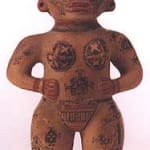Galo Polychrome Female Figurine, 500 CE - 800 CE
Terracotta
8 x 14.25
PF.3214
Galo Polychrome figures provide a wealth of ethnographic detail because of their realistic style. Coiffures, clothing, and careful body painting or tattooing are all clearly shown. Patterns acceptable for female...
Galo Polychrome figures provide a wealth of ethnographic detail because of their realistic style. Coiffures, clothing, and careful body painting or tattooing are all clearly shown. Patterns acceptable for female body decoration were probably different from those for males, for whom mythologically important animal traits predominate. Galo effigies are almost always female. The mirror-bright burnished surface is technically unsurpassed by any Pre-Columbian pottery, and the angular geometric patterns of reddish-orange, black and cream are impressively vivid. The guilloche (an ornament formed by two or more intertwining bands or intersecting lines) and woven-mat patterns are indicative of high rank. They represent the finest ceramics of the great tradition of polychrome pottery in Guanancaste- Nicoya.
Humans invented symbols, among the first of which was woman. . . the promise of life;
fertility with a human face. This gentle and thoughtful Galo Polychrome female looks as though she has philosophized over the significance of her purpose for eternity. An overwhelming concept, the promise of life or the creation of life, has puzzled humans since the beginning of time. It's difficult to imagine what the elaborate ornaments on her body precisely mean. We can only suggest that they are complex cosmogonies and rituals that will forever remain impenetrable. She stands before us with her coiffure drawn back from her forehead with ear spools and a tanga (pubic cover). Immediately her lips part and eyelashes flutter as if awakened from a dream, but it is only our consciousness which has awakened to the divine significance of our own creation.
Humans invented symbols, among the first of which was woman. . . the promise of life;
fertility with a human face. This gentle and thoughtful Galo Polychrome female looks as though she has philosophized over the significance of her purpose for eternity. An overwhelming concept, the promise of life or the creation of life, has puzzled humans since the beginning of time. It's difficult to imagine what the elaborate ornaments on her body precisely mean. We can only suggest that they are complex cosmogonies and rituals that will forever remain impenetrable. She stands before us with her coiffure drawn back from her forehead with ear spools and a tanga (pubic cover). Immediately her lips part and eyelashes flutter as if awakened from a dream, but it is only our consciousness which has awakened to the divine significance of our own creation.



